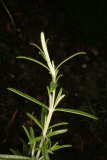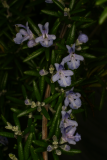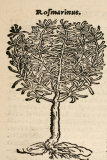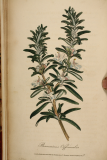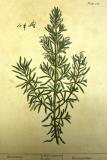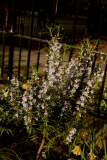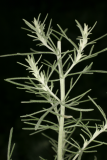Additional notes (click to expand)
Medicinal
Culpeper 1653: “... strengthen the brain exceedingly, resist madness, clear the sight.”
Notes (HFO): This is an extra reason for adding it to the joint of lamb, for the Sunday roast..
Culpeper, Nicholas. (1653). The London Dispensatory.
Dried leaves
Medicinal uses
Uses supported by clinical data
None.
Uses described in pharmacopoeias and well established documents
Orally as a carminative and spasmolytic to treat dyspepsia (9). Externally
for supportive therapy of rheumatism and circulatory disorders (13).
Uses described in traditional medicine
Orally as a cholagogue, diaphoretic, diuretic, emmenagogue and as a tonic
(3, 6, 7). Also used in the management of headache, menstrual disorders,
nervous menstrual complaints, tiredness and defective memory.
Used externally for treatment of spraining and bruising (15).
Contraindications
Folium Rosmarini [dried leaves] is contraindicated in cases of hypersensitivity or allergy
to the plant material.
From WHO Monographs on Selected Medicinal Plants Vol 4 2005, WHO Geneva
Medicinal uses of Essential Oil steam distilled from aerial parts of plant
Uses supported by clinical data
None.
Uses described in pharmacopoeias and well established documents
Used orally for the treatment of dyspeptic complaints, and in external applications
for supportive management of rheumatic complaints and circulatory
disorders (12, 13). Although one pilot study has indicated that thecrude drug may enhance cognition (13), further data from randomized
controlled clinical trials are required before any therapeutic recommendations
can be made.
Uses described in traditional medicine
Used as a cholagogue, diaphoretic, digestant, diuretic, emmenagogue,
laxative and a tonic (3, 5, 6). Also used in the management of headache,
menstrual disorders, nervous menstrual complaints, tiredness, defective
memory, sprains and bruises (14).
From WHO Monographs on Selected Medicinal Plants Vol 4 2005, WHO Geneva
Contraindications
Aetheroleum Rosmarini [Ed note: Essential Oil steam distilled from aerial parts of plant] is contraindicated in cases of hypersensitivity or
allergy to the plant material. It should not be used in patients suffering
from bronchial asthma or bronchitis or on damaged skin, such as in cases
of burns, lesions or skin rashes.
From WHO Monographs on Selected Medicinal Plants Vol 4 2005, WHO Geneva
Traditional Herbal Medicine Registration (THMR).
A member of the Lamiaceae family, Salvia rosmarinus (rosemary), an aromatic plant native to the Mediterranean region and now cultivated globally, has been used for centuries in cuisine and medicine, with several well-established biological activities.[1,2,3] Thought to contribute to preventing hair loss, rosemary oil was also used for hundreds of years in hair rinses in the Mediterranean area.[4] In traditional Iranian medicine, rosemary essential oil has been topically applied as an analgesic, anti-inflammatory, and anti-acne remedy.[5] Rosemary is known to absorb UV light well and to impart antibacterial and antifungal activity, as well as help maintain skin homeostasis.[3] It is also used and under further study for its anti-inflammatory, antioxidant, anti-infective, and anticancer activity.[2,6,7,8,9] The health benefits of rosemary are typically ascribed to its constituent carnosol/carnosic and ursolic acids.[7] In part 1 of this update on rosemary, the focus will be on chemical constituents, wound healing, anticancer activity, and hair care potential.
Rosemary. Cosmeceutical Critique. Leslie S. Baumann, MD https://www.medscape.com/s/viewarticle/1000103?ecd=WNL_mdpls_240302_mscpedit_infd_etid6345680&uac=70534PY&spon=3&impID=6345680
Nomenclature
Rosmarinus officinalis is a synonym.
Other use
(Formerly known as) Rosmarinus officinalis L. Lamiaceae Rosemary. Woody perennial. Distribution: Mediterranean. Quincy (1718) commended the flowers for epilepsy, apoplexy, palsies, uterine obstruction, jaundice, gout, and syringed into the ear with warm water for dislodging wax. It is licensed for use in Traditional Herbal Medicines in the UK (UK Medicines and Healthcare Products Regulatory Agency (MHRA)).
Oakeley, Dr. Henry F. (2013). Wellcome Library notes.
link
Geographical distribution
- Africa, Macaronesia, Canary Is.
- Africa, Macaronesia, Madeira
- Africa, Northern Africa, Algeria
- Africa, Northern Africa, Libya
- Africa, Northern Africa, Morocco
- Africa, Northern Africa, Tunisia
- Asia-Temperate, Western Asia, Cyprus
- Asia-Temperate, Western Asia, Turkey
- Europe, Southeastern Europe, Greece
- Europe, Southeastern Europe, Italy
- Europe, Southeastern Europe, Yugoslavia
- Europe, Southwestern Europe, France
- Europe, Southwestern Europe, Portugal
- Europe, Southwestern Europe, Spain
Salvia rosmarinus Spenn.
Family: LAMIACEAEGenus: Salvia
Species: rosmarinus Spenn.
Common names: Rosemary
Pharmacopoeia Londinensis name: Rosmarini/ Anthos
Distribution summary: N. Africa, Eurasia
Habit: Shrub
Hardiness: H5 - Hardy; cold winter
Habitat: Woodland, garigue, maquis, scrub, and rocky hillsides from sea level to 1300m
Garden status: Currently grown
Garden location: Pharmacopoeia Londinensis 1618 'Flowers' (HSE 1), Europe & Mediterranean (E), Plants in pots (POT)
Flowering months: March, April, May
Reason for growing: Medicinal, other use, traditional herbal registration
.JPG)
